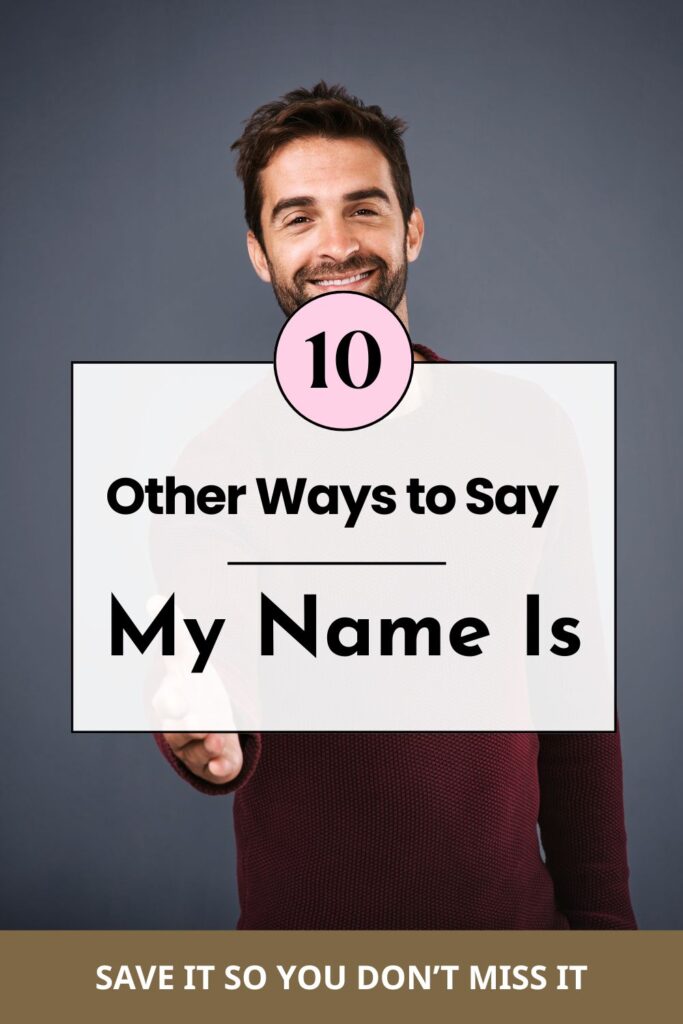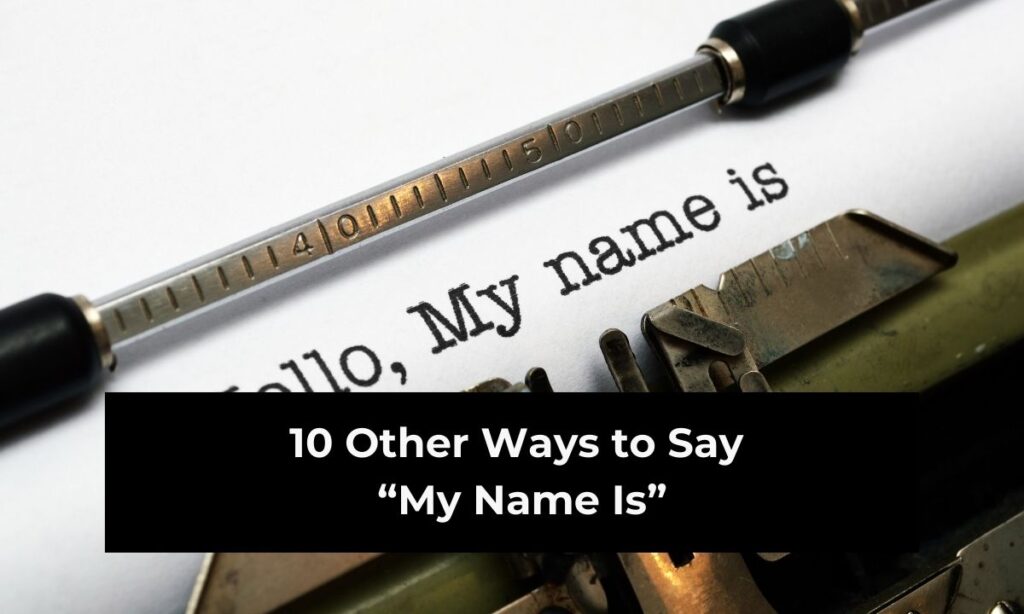When you meet someone new, one of the very first things you usually share is your name. It’s simple, polite, and the easiest way to start a conversation. But let’s be honest—saying “My name is…” can sometimes feel a little too routine, especially if you’re in a social setting, a networking event, or even just chatting online.
If you want to sound friendlier, more approachable, or even just a little creative, there are plenty of other ways you can introduce yourself. Changing up how you say your name not only makes your introduction more engaging but also helps you set the tone of the conversation. For example, a playful introduction works well in casual gatherings, while a polished one is perfect for professional settings.
Think about the last time you introduced yourself. Did it feel natural, or did you fall back on the same old “My name is…” line? If you want to stand out and leave a positive first impression, it’s worth experimenting with new ways of saying the same thing. Small shifts in your wording can make people remember you more easily.

In this article, you’ll find ten creative and versatile alternatives to saying “My name is.” Each phrase comes with practical examples and suggestions on when to use them, so you can confidently adjust your introduction depending on the situation. Whether you’re meeting someone face-to-face, hopping on a video call, or writing a quick message, you’ll never be stuck with the same basic phrase again.

Let’s explore the different ways you can say “My name is” and make your introductions more memorable.
1. “I’m [Your Name]”
Sometimes the simplest alternative is the most effective. Saying “I’m [Your Name]” is short, casual, and works in nearly every situation. It feels more conversational compared to the formal “My name is.”
For example, if you’re at a coffee shop and you strike up a friendly chat with someone, saying “I’m Alex” sounds more approachable than “My name is Alex.” It doesn’t create unnecessary distance—it feels like part of a natural flow of conversation.
This phrase is also ideal in professional contexts. When you’re introducing yourself during a team meeting, saying “I’m Sarah, and I’ll be working on the marketing project” sounds confident but not overly stiff. It shows professionalism while keeping the tone friendly.
Another advantage of using “I’m” is its flexibility. You can pair it with extra information depending on the situation. For instance:
- “I’m Jake, I work in product design.”
- “I’m Maya, I just moved here last month.”
- “I’m Chris, and I’ll be your trainer today.”
By adding a little more detail, you make your introduction not just about your name but also about who you are and what you bring to the table. That extra context often sparks conversation more easily.
If you want a go-to alternative to “My name is,” this is the most reliable option. It’s warm, clear, and suitable whether you’re introducing yourself to one person or to a room full of people.
2. “They Call Me [Your Name]”
If you want to make your introduction sound a little more playful or mysterious, try using “They call me [Your Name].” This phrasing can be a fun way to spark curiosity and set a lighter tone.
For example, at a casual party you might say, “They call me Emma.” It adds a touch of charm while still being clear. In a professional setting, it’s less common, but in creative industries—like music, design, or entertainment—it can actually make you stand out.
This phrase also works well when you want to highlight a nickname or a less formal version of your name. Let’s say your full name is “Jonathan,” but most people call you “Jon.” You might say, “They call me Jon,” which immediately signals how you’d like others to address you.
It also fits perfectly if you have a unique backstory tied to your name. For example:
- “They call me Ace, because I always find the shortcut in projects.”
- “They call me Bella, short for Isabella.”
When you use this phrase, you’re doing more than introducing your name—you’re creating an opening for someone to ask more about you. That’s great for breaking the ice in social settings or networking events.
So, if you’re feeling a little bold and want to stand out in a lighthearted way, “They call me [Your Name]” is a great alternative to the usual introduction.
3. “You Can Call Me [Your Name]”
This introduction strikes a balance between friendly and respectful. By saying “You can call me [Your Name],” you give people permission to use your name and make the interaction more comfortable.
For example, in a business setting, you might say, “You can call me Priya.” It signals that you want to make the conversation approachable. If your name is longer or formal, this phrase helps simplify things for the other person. For instance, “You can call me Sam, short for Samuel.”
It’s also helpful if you have a professional title but prefer a first-name basis in conversation. A doctor might say, “You can call me James,” instead of insisting on “Dr. Roberts.” This instantly puts people at ease and builds trust.
In social situations, it’s just as effective. Imagine meeting someone new in a group setting—you might say, “You can call me Jess.” It sounds warm, direct, and inviting without being stiff.
This phrase is especially useful if you’re in multicultural environments where people may be unsure how to pronounce your name. Offering a simpler version—“You can call me Nina, it’s easier”—shows consideration while still maintaining your identity.
Overall, “You can call me [Your Name]” works beautifully when you want to reduce formality and create a sense of connection right from the start.
4. “My Friends Call Me [Nickname]”
If you want to make your introduction personal and approachable, saying “My friends call me [Nickname]” is a great option. It tells people not just your name, but also gives a glimpse of your social side.
For example, if your name is “Alexander,” you could introduce yourself by saying, “My friends call me Alex.” This immediately makes you sound more relatable, and it encourages the other person to use the name that feels friendlier.
This approach is especially helpful in casual or social settings, like meeting new people at a gathering or joining a community group. Instead of sounding too formal, you set a tone of openness and friendliness.
It also works well when you want to build familiarity quickly. If you’re starting a new job, you might say, “My friends call me Danny, but Daniel is fine too.” This shows flexibility and makes it easier for others to feel comfortable addressing you.
In some cases, it can even make networking smoother. People tend to remember nicknames more easily, and tying your introduction to one can help you stand out in a crowd.
Just keep in mind that this phrase is better for informal or semi-formal situations. In very professional environments, you might want to stick with a more direct version until you get to know people better.
When you want to bring a personal touch to your introduction, “My friends call me [Nickname]” is a friendly and engaging choice.
5. “Allow Me to Introduce Myself—I’m [Your Name]”
This phrase carries a touch of old-fashioned charm while still sounding polished. “Allow me to introduce myself—I’m [Your Name]” works well when you want to make a confident, polite impression.
You might use it in professional environments, like at a business dinner or when speaking to a new client. For example: “Allow me to introduce myself—I’m Richard, the new project manager.” It shows formality but doesn’t feel overly stiff.
It can also be used in more casual settings if you want to add a little flair. At a social gathering, you might say, “Allow me to introduce myself—I’m Lila.” It sounds friendly while also giving your introduction a touch of personality.
This phrase works especially well when you’re meeting someone who may already know of you but hasn’t met you personally. For instance: “Allow me to introduce myself—I’m Grace, I’ll be handling your account moving forward.”
It also pairs nicely with humor if you want to lighten the mood. For example: “Allow me to introduce myself—I’m Jason, unofficial coffee expert in this office.” That little twist helps you be remembered.
If you want to come across as confident, polished, and approachable, this alternative to “My name is” is a perfect fit.
6. “I Go By [Your Name or Nickname]”
When you say “I go by [Your Name],” you’re not only introducing yourself but also clarifying how you’d like others to refer to you. This phrase is particularly useful if you have multiple names, a nickname, or if people often mispronounce your name.
For instance, someone named “Elizabeth” might say, “I go by Liz.” It’s direct and saves the other person from any confusion. Similarly, if you have a name that is spelled or pronounced differently, this phrase clears up misunderstandings early on.
This approach works well in both casual and professional environments. Imagine joining a new workplace—you might say, “I go by Chris.” It’s concise and tells people exactly how to address you moving forward.
It also works nicely in creative industries, where people often have stage names or pen names. For example, “I go by Aria when I perform.” This helps you separate your professional and personal identity while keeping the introduction smooth.
Another benefit is that it allows flexibility. If you’re comfortable with multiple versions of your name, you can use this phrase to highlight your preference without being too rigid. For example: “I go by Nikki, but Nicole works too.”
By using “I go by [Your Name],” you make your introduction practical, clear, and memorable—perfect for situations where you want to avoid confusion while staying approachable.
7. “It’s [Your Name]”
“It’s [Your Name]” is one of the most casual and friendly ways to introduce yourself. It works especially well in relaxed settings where formality isn’t needed.
For example, if you’re walking into a friend’s gathering and someone asks who you are, you could say, “It’s Mark.” It feels laid-back and natural, almost like you’ve already been part of the group.
This phrase also comes in handy when you’re re-introducing yourself to someone you’ve met before but who may not remember your name. A cheerful “It’s Emily—we met last week” keeps things light and avoids any awkwardness.
You can also use this line in digital settings, like emails or chats. Starting with “It’s Jenna from the design team” immediately makes your message feel more personal and less stiff.
The key benefit of using “It’s [Your Name]” is how effortless it sounds. It doesn’t feel forced, and it creates a sense of friendliness right away.
This option is best for casual or semi-formal introductions where you want to sound approachable and easygoing. It may not be the best fit for very formal scenarios, but for everyday conversations, it’s one of the easiest ways to replace “My name is.”
8. “People Know Me As [Your Name]”
If you want to create a sense of familiarity while introducing yourself, try saying, “People know me as [Your Name].” This phrase can make your introduction feel more engaging, especially when you’re in settings where reputation or recognition matters.
For example, at a professional event you might say, “People know me as Daniel from the marketing team.” It adds context and instantly helps the other person connect the dots.
This phrase also works when you have a nickname, alias, or stage name. For instance: “People know me as Luna when I perform music.” It draws attention and gives people a sense of who you are beyond just a name.
Another great use is in online spaces. When introducing yourself in a community or forum, you could say, “People know me as Jay in the design circles.” This makes it easier for people to place you if they’ve seen your work before.
It’s also a good way to introduce yourself if you’ve built a personal or professional brand. Saying, “People know me as Sarah, the travel blogger” instantly ties your name to your identity and helps you be remembered.
This phrase adds personality to your introduction and makes it more than just an exchange of names—it becomes a conversation starter.
9. “For Short, You Can Say [Nickname]”
If your name is longer or has a common nickname, introducing yourself with “For short, you can say [Nickname]” is an easy way to make things simpler for others.
For example, someone named “Christopher” might say, “For short, you can say Chris.” This not only helps people remember your name but also sets the tone for how you’d like to be addressed.
This approach is especially helpful in multicultural environments where names might be unfamiliar or difficult to pronounce. Offering a shorter or easier version shows thoughtfulness while still respecting your full name.
It also works in professional settings where quick introductions matter. Saying, “For short, you can say Ben” keeps things efficient without losing friendliness.
In casual gatherings, it can make you sound approachable and down-to-earth. If your friends call you by a nickname, this phrase helps others adopt it naturally without awkwardness.
You can also use it to show flexibility. For example: “For short, you can say Jen, but I’m fine with Jennifer too.” This way, people know your preference without feeling pressured.
If you want to simplify introductions and make it easy for people to connect with you, “For short, you can say [Nickname]” is a practical and friendly alternative to “My name is.”
10. “Introducing Myself—I’m [Your Name]”
Ending with a confident and clear option, “Introducing myself—I’m [Your Name]” works especially well in formal or semi-formal situations. It shows that you’re taking the initiative to share who you are.
For instance, during a meeting with new colleagues, you might say, “Introducing myself—I’m Laura, part of the finance team.” It sets a professional yet approachable tone.
This phrase also works in digital communication. In an email to a new client, you might write: “Introducing myself—I’m Daniel, and I’ll be your point of contact moving forward.” It’s polite, professional, and clear.
In social situations, it can also make you sound polished without being overly stiff. At a networking event, for example: “Introducing myself—I’m Zoe. I specialize in graphic design.” It leaves a solid first impression while giving people something specific to remember about you.
This phrase works best when you want to establish credibility and clarity from the start. It tells people that you value introductions and are intentional about making a connection.
If you want an alternative that feels respectful and versatile, “Introducing myself—I’m [Your Name]” is a great choice.
Conclusion
Introducing yourself is one of the simplest yet most powerful parts of any interaction. While “My name is” is the standard go-to phrase, you don’t always have to rely on it. Changing up the way you introduce yourself allows you to control the tone of the conversation, whether you want to be formal, approachable, playful, or professional.
Each of the alternatives we’ve explored—from “I’m [Your Name]” to “Introducing myself—I’m [Your Name]”—gives you a slightly different way to express who you are. Some are perfect for relaxed, everyday conversations, while others shine in business or networking environments.
The key is to choose the introduction that feels most natural for you and suits the setting you’re in. A creative or personal introduction can help you stand out, build rapport, and make your name stick in someone’s memory.
Next time you’re about to meet someone new, think about the impression you want to leave. A small shift in your wording can completely change the way others perceive you. By trying out these alternatives, you’ll not only feel more confident introducing yourself but also make every first impression a little more memorable.
FAQs
1. Is it okay to use informal introductions in professional settings?
Yes, as long as the tone is respectful. “I’m [Your Name]” or “You can call me [Your Name]” are informal but still appropriate for work.
2. What if people struggle to pronounce my name?
Offer an alternative with phrases like “I go by [Your Name]” or “For short, you can say [Nickname].” It helps others feel comfortable while respecting your identity.
3. Should I always use the same introduction?
Not necessarily. Adjust your introduction to fit the situation—formal in business settings, casual among friends, and flexible online.
4. Can I use humor when introducing myself?
Absolutely. A lighthearted twist can make your introduction memorable, especially in social settings, as long as it suits the context.
5. What’s the most versatile alternative to ‘My name is’?
“I’m [Your Name]” is the most versatile. It works across formal, casual, and digital environments without sounding forced.





